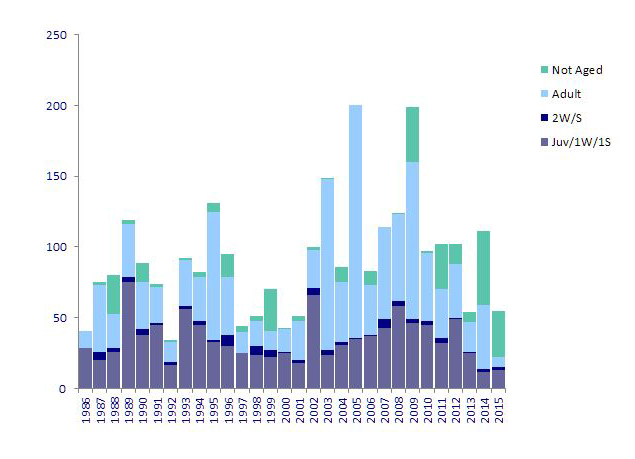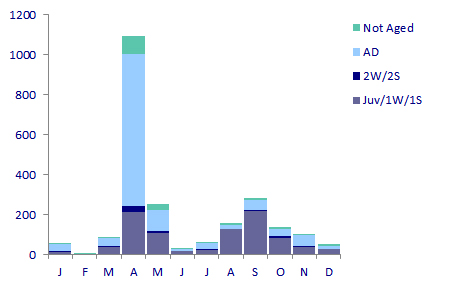Little Gull Hydrocoloeus minutus |
Regular passage migrant, generally in small numbers, and occasional winter visitor
Little Gulls are regular visitors to the region, though numbers have been somewhat variable with peaks during the late 1980s, mid-1990s, in 2003 and all-time highs in 2005 and 2009.
The annual distribution of records between 1986 and 2015 is displayed in Figure 1. As with several of the scarcer species, available age-data has been has been somewhat piecemeal in more recent years; no doubt un-aged individuals primarily involved adults or undiagnosed 2W / 2S.

Figure 1. Annual distribution of Little Gulls in the West Midlands region, 1986 - 2015.
This period produced a grand total of around 2750 birds, while annual numbers have varied between 34 in 1992 and at least 200 in 2005 and 2009 (in years of heavier passage it is not always possible to distinguish new arrivals from individuals remaining from the previous day). The year 2005 was also the peak year for adults (164), whereas 1989 was the peak for first-years (75).
There have been records in all months of the year but with clear peaks in the passage periods of April (May) and September. The monthly distribution of records between 1986 and 2010 is displayed in Figure 2.

Figure 2. Monthly distribution of Little Gulls in the West Midland Region, 1986 - 2010.
The peak for adults is conspicuously during April whereas first-years are more evenly distributed between spring and autumn, with peaks during April and September. Second-years are relatively scarce (though some are perhaps overlooked as adults) but, as with adults, April is the most productive month.
The spring passage now peaks somewhat earlier compared with the situation evident prior to 1978. The analysis presented in The Birds of the West Midlands (Harrison et al., 1980) revealed a peak during May for all age categories combined. However, even at that time adults peaked a little earlier, during April.
Most records involve just one or two individuals, with flocks up to half-a-dozen quite regular. Occasionally larger flocks of 20 to 30 birds occur while the largest flocks recorded have been as follows:
72 ('nearly all adults'), Draycote Water, Warks, April 25th 2005.
50 (42 adults), Draycote Water, Warks, April 17th 2009
39 (36 adults, 2 second-year and 1 first-year), Coton, Warks, April 22nd 1987.
|
|
|
|
Home |
Mediterranean
| Laughing |
Franklin's |
Little |
Sabine's |
Bonaparte's |
Black-headed |
Ring-billed | Common |
Lesser Black-backed | |